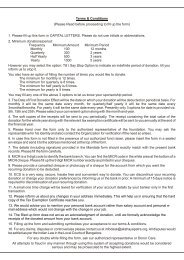The Top 100 NGOs 2013. - Akshaya Patra
The Top 100 NGOs 2013. - Akshaya Patra
The Top 100 NGOs 2013. - Akshaya Patra
Create successful ePaper yourself
Turn your PDF publications into a flip-book with our unique Google optimized e-Paper software.
a makeshiFT TenT ciTy<br />
amiD <strong>The</strong> ruins in PorTau-Prince<br />
aFTer <strong>The</strong><br />
earThQuake<br />
©un PhoTo/logan aBassi<br />
<strong>The</strong>re were no longer bodies to be<br />
found in the rubble. Medical teams<br />
still working had moved on to treating<br />
car-crash victims and malaria. To most<br />
people in the streets – where nearly<br />
every quake survivor, including me,<br />
was sleeping – it was time to try and<br />
restart businesses, and cobble together<br />
some form of adequate if temporary<br />
housing. In humanitarian workers’<br />
parlance, Haitians were moving from<br />
‘relief’ to ‘recovery’.<br />
At this crucial juncture, the<br />
underpinnings of the reconstruction<br />
that was to follow were being laid. <strong>The</strong><br />
places where Haitians were settling<br />
would be their homes for months at<br />
least. <strong>The</strong> way in which post-quake<br />
land use quickly evolved would become<br />
the new normal for years. But the<br />
UN system, foreign militaries and<br />
<strong>NGOs</strong> were largely oblivious to this<br />
reality, still stuck in the relief phase.<br />
Outside Haiti, images of the first<br />
terrible hours after the quake remained<br />
in high rotation on television and in<br />
other media. Fundraising and the<br />
gathering of immediate relief supplies<br />
continued unabated. Donors preferred<br />
organizations such as the American<br />
Red Cross – whose $486 million in<br />
funds raised far exceeded what an<br />
organization that, in the words of its<br />
spokeswoman Jana Sweeny, did not<br />
FeaTure FeaTure<br />
“do development,” could spend.<br />
“<strong>The</strong>re’s only so much money that<br />
can be forced through the emergency<br />
phase,” she added.<br />
<strong>The</strong> main problem, however, was a<br />
continuing lack of communication. As I<br />
recount in the book:<br />
Though concerns about security had<br />
proved unwarranted, most cluster<br />
meetings were held inside the security<br />
perimeter at the UN Logistics Base<br />
on the airport road. That meant few<br />
Haitians could attend. And since nearly<br />
all the meetings were held in English, few<br />
Haitians could have understood anyway.<br />
(This was explained via an International<br />
Federation of the Red Cross report with a<br />
tautology: “<strong>The</strong> language of the national<br />
cluster remained English because only<br />
English speakers attended the early<br />
meetings.”)<br />
<strong>The</strong> cluster participants rarely ventured<br />
into the city, to say nothing of the<br />
countryside, themselves. An early<br />
exception was Mike Godfrey, an aid<br />
worker with decades of experience who<br />
had spent the previous year and a half<br />
overseeing a USAID agriculture and<br />
watershed management program in the<br />
Haitian countryside. Both Godfrey<br />
and his rented apartment in Pétionville<br />
survived the earthquake, and unlike<br />
<strong>The</strong> gloBal Journal + January & FeBruary 2013<br />
most participants, he continued to live<br />
outside the security perimeter, making the<br />
four-hour round trip each day. At first<br />
he wasn’t quite sure what role he could<br />
play. “I’ve been here,” he remembered<br />
thinking. “I know what’s going on.”<br />
What was going on – at the meetings<br />
and in the streets – disturbed him. <strong>The</strong><br />
‘LogBase’ [UN logistics base in Port-au-<br />
Prince] bull sessions were dominated by<br />
bureaucratic procedure. With aid workers<br />
constantly rotating in and out, many<br />
staying for only a few weeks, nearly<br />
every meeting had to burn time getting<br />
newcomers up to speed. <strong>The</strong> meetings<br />
about shelter issues rarely addressed<br />
the estimated 600,000 people who had<br />
spontaneously decongested the capital by<br />
moving to their ancestral homes in the<br />
countryside. Thousands more had moved<br />
to the relatively open land between the<br />
capital and the Dominican border.<br />
Godfrey had overseen CARE USA’s<br />
operations after the 1998–1999 war<br />
in Kosovo, when at least 1.2 million<br />
refugees were driven from their homes.<br />
Responders in the Balkans made a point<br />
of delivering aid to individual families<br />
instead of squatter camps, for fear of<br />
encouraging people to stay in them, he<br />
recalled, and followed refugees’ lead<br />
when they returned to their homes on<br />
their own. If the aid effort in Haiti could<br />
a TenT ciTy insTalleD<br />
near <strong>The</strong> airPorT oF PorTau-Prince<br />
©un PhoTo/marco Dormino<br />
similarly deliver resources to people<br />
outside of the capital, Godfrey and many<br />
others reasoned, this might incentivize<br />
them to remain where they were, solving<br />
one of the country’s biggest problems.<br />
In Port-au-Prince, he was convinced, as<br />
water, medical care, food, and services<br />
were brought directly to the camps,<br />
the new settlements would become<br />
permanent. He tried to explain this to<br />
people working on camp handouts, but<br />
they were too busy to listen. As Godfrey<br />
watched thousands who’d fled seep back<br />
into the capital, he stopped going to<br />
meetings all together. At one of his last,<br />
the aid worker – whose stout jaw, wavy<br />
yellow hair, and groomed white beard<br />
could make him a convincing extra in<br />
Julius Caesar – stood up and asked,<br />
“how can you continue to function when<br />
there isn’t a person who’s been here for<br />
more than three weeks, and the chairman<br />
arrived yesterday?” Most participants<br />
agreed but could only shrug.<br />
<strong>The</strong> Haitian government –<br />
undermanned, underfunded, and,<br />
in many ways equally out of touch –<br />
was also at a loss. For a while, its<br />
officials were in denial as well. But it<br />
did not take long for the new reality to<br />
become clear to everyone. In February,<br />
US officials and allied aid groups were<br />
still proposing a three-phase plan in<br />
which most of the estimated 1.5 million<br />
post-quake homeless would be relocated<br />
to new, managed camps, housed in<br />
125,000 durable ‘T-shelters’ to be<br />
constructed from tarps, metal, and<br />
plywood. Yet by July, when fewer than<br />
6,000 had been constructed, it was clear<br />
that this program had failed. By failing<br />
to take into account how Haitians<br />
would manage their own recovery, and<br />
unable to tackle larger issues such as<br />
land tenure, the resurgent ‘Republic of<br />
<strong>NGOs</strong>’ had nothing to add. And despite<br />
best intentions, high profile figures like<br />
Sean Penn were bestowed with a level<br />
of influence way beyond their expertise.<br />
Many intra-city camps are still where<br />
they were in early February 2010. Those<br />
individuals and families that have been<br />
evicted, sometimes violently, have either<br />
moved to buildings equally or more<br />
dangerous than those that collapsed<br />
during the earthquake, or have fallen<br />
off aid groups’ radars completely.<br />
<strong>The</strong> cluster system did succeed in<br />
a few ways. At an organizational<br />
level, there was most likely more<br />
coordination amongst <strong>NGOs</strong> than<br />
in the past, and an unprecedentedly<br />
open relationship between military and<br />
civilian responders. But the nature of a<br />
top-down, highly centralized model, as<br />
opposed to a broader-based approach<br />
involving Haitians, meant that critical<br />
<strong>The</strong>gloBalJournal.neT<br />
98 99<br />
mistakes were made at the beginning.<br />
And the result of that early failure<br />
will be felt for years to come. Make no<br />
mistake: that Haiti was let down after<br />
the earthquake is not in dispute among<br />
those who live there. While, as always,<br />
there are some <strong>NGOs</strong> that can point<br />
to successful individual projects, the<br />
overall effort has not fulfilled its<br />
lofty promise. Poverty is as dire as<br />
ever. Hunger is worsening. At the<br />
three-year mark, post-quake<br />
homelessness remains a crisis, and new<br />
housing options are not addressing<br />
the critical need for future resilience<br />
and disaster preparedness. Cholera, a<br />
disease never before confirmed in Haiti,<br />
has claimed 7,500 lives since being<br />
introduced by foreigners – with all<br />
evidence pointing to a contingent of<br />
UN peacekeepers stationed beside a<br />
rural tributary.<br />
<strong>The</strong> good news is that Haiti’s story isn’t<br />
over. <strong>The</strong> earthquake proved that a<br />
mere increase in attention and even a<br />
surge of new funds is not enough. But<br />
if there are real changes in attitude and<br />
action – if responders can find ways<br />
to not only truly work with Haitians<br />
themselves, but follow the public’s<br />
lead – the cycle can be broken. <strong>The</strong> real<br />
project of allowing Haiti to stand up on<br />
its own can succeed, and the <strong>NGOs</strong> can<br />
finally go home.<br />
the biG trUck that Went by<br />
JonaThan m. kaTz<br />
Palgrave macmillan<br />
£17.99





